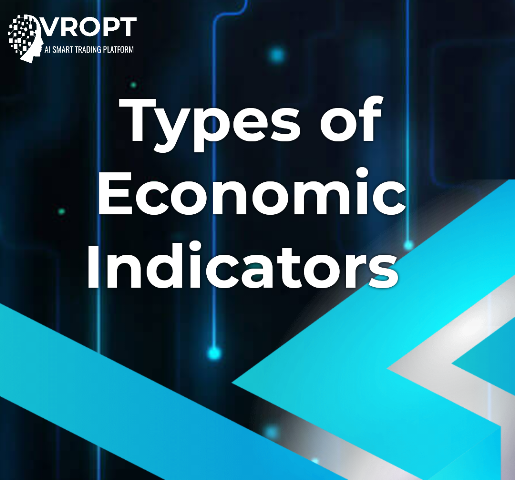
Economic Indicators
An economic indicator is a piece of macroeconomic data used by analysts to interpret economic conditions for current or future investment purposes. These indicators also help judge the overall health of an economy. Each country publishes very different economic indicators, but specific data published by government and non-profit organizations are widely followed. Such indicators include consumer price index (CPI), gross domestic product (GDP), unemployment data, etc.
An economic index is a macroeconomic measure used by analysts to understand current and future economic activities and opportunities.
Some indicators can be “leading” that are ahead of trends and predict the likely direction of future economic activity. Some are “Lagging” who confirm trends. Some indicators are “matched” or simultaneous, which report the current state of the economy.
Indices can provide investors with insight into how trades are performing, although data uncertainty and variable inconsistency may limit their utility.People who measure economic activity and predict future directions rely on analyzing key components of macroeconomic data.Economic indicators measure everything from economic growth to changes in prices and unemployment.Markets can be moved by news related to economic indicators.
Why are economic indicators important?
In today’s fast-paced and interconnected business landscape, making informed decisions is critical to staying ahead of the competition. As a trader, you are constantly navigating the intricacies of the market, trying to predict the next trend and setting yourself up for success.
But have you ever thought about the fundamental forces that shape the economy and ultimately the fortunes of your business? Economic indicators are subtle yet powerful signals that can make the difference between growth and stagnation, profit and loss. With these key metrics, you can gain a deeper understanding of the economic landscape, identify opportunities, and make data-driven decisions that move your business forward.
Important economic indicators that you should know
Economic indicators are basically a criterion for analyzing the performance of a country, and it plays an important role in the sustainable development and well-being of citizens.
Usually, these economic indicators are evaluated and published by government agencies and international financial institutions such as the World Bank or the International Monetary Fund. These results are very important for people who work in financial markets, in simple words:
These indicators are extracted from economic activities and financial markets of the country.
By analyzing and interpreting these indicators, as well as understanding the concept and use of statistics and figures, the market trend can be predicted to some extent. In the following, we will introduce you to some of the most important economic indicators that affect the financial markets.
Interest Rate
When it comes to interest rates, taking a bank loan and paying bank interest is the first thing that comes to mind. This is the rate that the bank charges to prevent the depreciation of the money paid today. Due to the time value of money, an amount called interest is paid to the lending person or company, and this is because the opportunity to invest and use the money is taken.
Interest rate is an important tool of monetary policy and is used to control inflation. Central banks of countries use interest rates if they want to reduce or increase investment or regulate inflation. Developed countries consider the interest rate as a tool to maintain inflation in the appropriate range, for economic health and to reduce the interest rate at the same time as the economic growth.
The interest rate is one of the central bank’s tools to advance its monetary policy goals. Therefore, before investing, investors should predict the policy of the central bank by checking this rate.
According to the economic conditions, the central bank adopts expansionary and contractionary monetary policies and controls the money supply by implementing each of these policies. Expansionary monetary policy is implemented during recession and contractionary monetary policy during inflation.
The importance of examining the interest rate is its effect on economic growth, parallel markets, inflation, recession, dollar rate, etc. Investors should know under what conditions they are investing and how much profit they will earn.
The effect of interest rates on economic growth
The interest rate should be chosen in such a way that there is a balance between this rate and economic growth. Its excessive increase causes a decrease in economic growth, and an excessive decrease leads to other problems such as an increase in inflation.
To put it more simply, the increase of this rate causes a decrease in banking facilities, GDP and, as a result, a decrease in economic growth.
Investment: An increase in interest rates makes investors less willing to invest in long-term projects. In other words, with the increase of this rate, the cost of providing capital increases. As a result, investors are more inclined to invest in short-term projects and bank deposits.
Demand: As the interest rate increases, the demand at the community level decreases. Due to the decrease in demand and the loss of producers, the increase of this rate will have a negative effect on the growth of the economy.
Inflation: With the increase of this rate, the cost of providing capital for companies increases, and as a result, the cost of producing goods and services increases. This increases inflation in the economy.
The relationship of interest rates on the economic situation
Determining this rate is one of the important monetary policy tools that the central bank chooses to control inflation and recession. In other words, the interest rate is one of the central bank’s tools to improve the country’s economic situation.
The increase or decrease of this rate leads to the control and change of the following factors:
Stimulating investment: the central bank tries to encourage investors to deposit in the bank by increasing the interest rate. It should be noted that the interest rate is determined according to the economic situation of the country.
Inflation control: The central bank controls inflation by setting this rate. Its increase leads to a decrease in liquidity and stagnation in parallel markets such as gold, cars and housing.
Capital attraction: The central bank can encourage domestic and foreign investors to attract capital in the country by setting the appropriate rate. With the attraction of capital, the amount of investment, employment and economic growth increases.
Balance in the foreign exchange market: The central bank can maintain the balance in the foreign exchange market by determining the appropriate interest rate. By increasing this rate, the value of the national currency increases, and this can reduce the demand for buying foreign currency. As a result, it will reduce the pressure on the value of the national currency.
Increasing investment in different economic sectors: Central Bank can encourage investors to invest in different economic sectors by setting the interest rate appropriate to the economic conditions. With the attraction of capital, the amount of employment and economic growth increases.
The relationship between interest rates and the capital market
The interest rate has the property of directing other markets. When this rate increases, it is more profitable and less risky for investors to keep money in the bank.
An increase in this rate will reduce activity in the financial markets and decrease the value of stocks and other securities. According to the economic conditions and the diagnosis of the central bank, the reverse of this issue is also possible in the way that the interest rate will decrease and they will be more attractive for investment compared to other markets.
The effect of interest rates on inflation
Some consider the definition of inflation and inflation expectations to be the same, but it is not true. Inflation means the continuous increase in the general level of prices of products and services in a certain period of time. While the inflation expectation is the rate that the people of a country expect from price increases in the future.
The power of inflationary expectations is greater than inflation itself, because at this time people expect the price of products to increase in the future, and they turn to buying durable goods to prevent the depreciation of their currency. In this regard, they withdraw their money from visual and non-visual deposits. In this situation, the central bank increases the interest rate to curb inflation.
Gross Domestic Product (GDP)
An economy’s gross domestic product calculates and provides the total value of goods and services that the economy produces and shows whether it is growing or declining.
A growing GDP indicates a growing economy, while a declining GDP indicates a recession. As a trader, understanding the GDP growth rate is very important because it can have a direct impact on your company’s performance.
For example, a strong GDP growth rate can lead to increased consumer spending, higher demand for products and services, and a more favorable business environment. On the other hand, a low GDP growth rate may indicate a need to adjust your business strategy, such as cutting costs, diversifying revenue streams, or exploring new markets.
By closely monitoring your GDP growth rate, you can make informed decisions about investment, hiring, and resource allocation, ultimately helping your business thrive in any economic climate.
Inflation Rate
A metric that can make or break your business’s financial fortunes. At its core, inflation measures the rate of increase in the prices of goods and services. But what does this mean for your business bottom line?
Simply put, inflation can reduce your profit margins, increase your operating costs, and even affect consumer behavior.
For example, if inflation is high, consumers may become more cautious with their spending, leading to lower sales for your business. On the other hand, if inflation is under control, customers may open their wallets more and increase your income.
Unemployment Rate
The level of the unemployment rate reveals the overall health of the economy. While a low unemployment rate may seem like a simple indicator of a thriving economy, it’s important to look deeper.
A low unemployment rate can sometimes mask underlying issues, such as a significant number of part-time or temporary workers, who may not have the same level of job security as their full-time counterparts. In addition, the low unemployment rate can also be influenced by the decrease in the labor force rather than the increase in job opportunities.
By examining labor force composition, unemployment duration, and types of jobs created, business leaders can gain a more accurate understanding of the labor market and its implications for their organization.
For example, if the majority of new jobs are in low-wage or low-skilled sectors, this may indicate a lack of investment in human capital, which can have long-term consequences for productivity and economic growth. By looking beyond the unemployment rate, business leaders can make more informed decisions about talent acquisition, resource allocation, and strategic planning.
Consumer Confidence Index – why it is the key to economic growth
The Consumer Confidence Index (CCI) is a vital economic indicator. This measure measures consumers’ optimism about the overall state of the economy and their personal financial situation. The CCI is a key indicator of economic growth because it has a direct impact on consumer spending, which makes up a significant portion of the economy.
When consumers are confident, they are more likely to open their wallets and spend, which can increase sales, spur economic growth and create new jobs. On the other hand, a decrease in consumer confidence can lead to lower spending, lower sales, and even recession. By monitoring CCI, business leaders can gain valuable insight into consumer behavior and adjust their strategies accordingly.
For example, if the CCI is trending upward, it may be a good time to invest in new products, expand marketing efforts, or hire more employees. Conversely, if the CCI is declining, there may be a need to reduce production, cut costs, or develop contingency plans.
Yield Curve Index
This index is an important index in the capital market that shows the relationship between risk and investment returns. This index is usually plotted using given points from the capital market and changes in the price of investments.
In the yield curve index, the horizontal axis usually represents the risk (usually using the variance or standard deviation) and the vertical axis represents the investment return. This chart shows how the return on investments changes according to their risk.
The yield curve usually consists of two parts: the upper part, which represents the return of investment in high risk conditions, and the lower part, which represents the return of investment in low risk conditions. The yield curve is used as an important analytical tool for investors to understand the relationship between risk and return of investments and make better decisions for managing their portfolio.
According to the yield curve index, investors can choose the best investment combination between different assets to achieve their goal in terms of risk and return.
Purchasing Managers’ Index (PMI)
This economic index is one of the most important economic data that expresses the state of economic growth. PMI is related to private sector companies, and in order to calculate more than four hundred purchasing managers, they are asked to announce the status of the company and issues such as new orders, employment, inventory, receipt of goods, and outstanding orders.
PMI shows the state of boom and bust in different business sectors and this statistic can be used to analyze market traders.
Retail Sales
Whenever goods or services are purchased by consumers and businesses, we talk about the retail sales index. These goods and services are finalized and reach the consumer in the last stage of supply.
The supply of goods starts from the raw materials, then it is manufactured by the manufacturer. Major sales have been made to retailers. Finally, retailers provide them to consumers.
Retail sales include the sales of durable and non-durable goods and services in a specific period of time for which data is published in the United States every month. This index is important because it shows the amount of demand for consumer goods. This rate is of interest because consumer expenses determine almost 70% of the total economic production of the country.
Industrial production (IIP)
Another economic indicator that determines the actual output of industrial production is the report of industrial production. This statistic is considered a short-term indicator and is used to evaluate the performance of the economy.
This index is very important due to the effect of fluctuations in its activity level on other indices. Price changes do not affect this index. Therefore, it can well show the real performance of related departments and is used as a measure to measure short-term changes in added value.
Trade balance
The trade balance is one of the economic indicators that is analyzed in the fundamental analysis of the countries’ currencies. The difference between the monetary value of imports and exports during a certain period is called trade balance or net export. If export is more than import, its value is positive, and if import is more than export, its value is negative.
A positive balance is known as a trade surplus and a negative balance is known as a trade deficit. In fact, a positive trade balance is effective in more employment, reducing unemployment, increasing capital receipt, promoting companies and improving the quality of life of people in the society.
Average Earning
Wages are specific amounts paid to workers in cash, non-cash, or a combination of both for certain hours of work. But salaries are certain amounts that are paid to the employee monthly or annually in exchange for intellectual or physical work or a combination of these two activities.
In addition to inflation, labor market conditions, the history of the company’s salary structure, fringe benefits, productivity indicators of the company’s profit, information related to the circulation of goods and the consumer price index can be mentioned as other measures of salary increase.
Treasury yield rate
Bonds are debt instruments that are issued by companies or governments to provide the required capital with a relatively low interest rate.
Governments offer these bonds at different levels. For example, the United States issues bonds at the federal, state, and municipal levels and can be repaid periodically at 30-day, 60-day, 120-day, three-year, five-year, ten-year, and thirty-year intervals.
The effective annual return is based on the price paid for the bond. The yield of bonds has an inverse relationship with the price of bonds. Actually, the difference is the maturity price of bonds and their current price.
What are the advantages of economic indicators?
- Measuring the performance of the economy
Economic indicators help us measure the performance of the economy quantitatively and relatively accurately.
- Anticipate changes
By using economic indicators, it is possible to predict possible changes in the economy and plan for the future.
- Comparison with previous years
By using these indicators, it is possible to compare the current performance of the country with previous years and express one’s opinion about progress or lack of progress.




